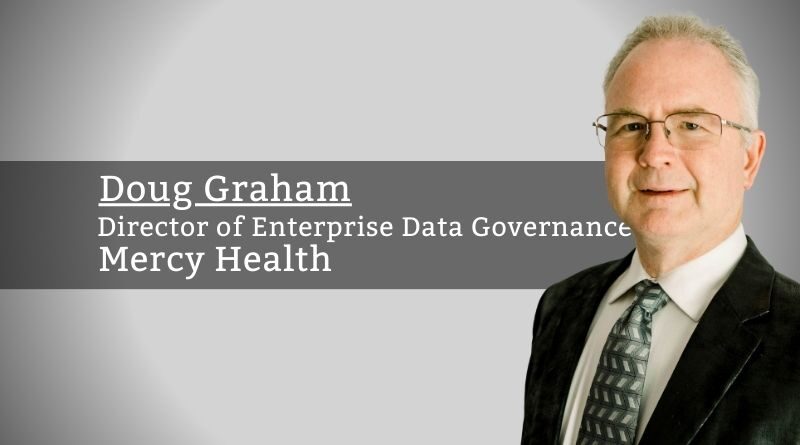Data Governance enabling Transformation, Interoperability and Privacy (TIP)
By Doug Graham, Director of Enterprise Data Governance, Mercy Health
While introducing data governance to a provider onboarding summit, I asked the question, “What do you think of when you hear the term Data Governance?”
The response… “run the other way!”
By the end of the presentation, the teams were relating to the “purpose” of data governance…
- It seeks to break down organizational barriers that lead to silos who work independently and don’t “trust” their peers from other business units as it relates to the data.
- It aims to involve the community of professionals who share common data subjects like Providers and Locations into a unified language set that allows them to understand one another.
- It introduces the potential to interoperate data between organizational boundaries when the terms used to describe that data are the same.
- It facilitates understanding of the footprint of data throughout the organization and organizes it in ways that can be understood by those who are on the front line of maintaining that data.
- It empowers the caregivers on the front line with the right tools to heal valuable data assets.
Transformation Strategy Alignment
Good Enterprise Business Architecture practices will identify an organization’s strategic objectives alongside its’ core capabilities. Where capability gaps exist, it will seek to close those gaps with process improvement efforts. Process improvement efforts invariably involve data. Therefore, to close business capability gaps, data governance fits into the strategic plan.
Transformation transformation
The prioritized list of projects for the strategic plan can be organized into a new grouping of Data Governance Subject Area’s for an organization. Health care can be organized by core subject areas (Domains) Providers, Consumers/Patients, Payers, Locations, Clinical Services, Finance, etc. The project’s focus will generally fall into one of these core domains and the critical data that needs defining can often be broken down by project. Where there are common critical data defined across multiple projects, then the unification of the definitions becomes imperative. Define once then reuse the definitions, independent upon where they are “prioritized”. A new and separate but parallel body of works begins to take formation. This is referred to as the Data Governance Working group. These working groups define the common data across organizational business areas in a collaborative setting. With projects set aside, these groups pre-define the data that becomes the scope of the future project. The beauty of the new process falls in the realization that in defining it, you have come face to face with a decision on “where” it is to be maintained. This is where interoperability begins to register among the business process stakeholders.
The core technology enablers for transformation through governance are the Glossary, Catalog, and Data Quality Platforms.
Staging the Interoperability Affect
Interoperability affects everything in an organization. When we interoperate, we serve patients according to our strengths and training. When we interoperate with data, we inform consumers according to reliable and “agreed upon” standards. Agreement does not happen in a vacuum. It is a very intentional effort that requires executive attention and focus and resolves down to the operational imperatives. This is where the Data Governance Framework comes into play. Distilling the organization that spans multiple regions and departmental boundaries can seem to be a daunting task. The discovery of the natural tendencies of leadership influence may prove to align rather well with the common data domain constructs for health care. Searching out the leadership councils that drive business priorities and shifting the lens to the data domain focus may result in reasonable outcomes.
Now that we have the organizational focus on data, we must consider some key technology enablers to accomplish this transformation. The core technology enablers for transformation through governance are the Glossary, Catalog, and Data Quality Platforms. Glossaries align business meaning to the Domain-based framework across departments and include data “classification”. Catalogs organize physical data constructs across organizational departments and can automate the classification as agreed on by the Domain authorities in the glossary. The third leg in this Governance construct is the data quality connection that extends the domain decisions regarding classification and reference data authorization and applies measures that report back to the domain authorities regarding progress toward standardization.
Privacy Play
The technical tooling that supports data governance implementation, coupled with a renewed awareness of business processes that can be standardized to drive value and strategic alignment, now presents new opportunities to address organizational data sprawl problems. Governance artifacts deliver common business meaning to terms that tell the tools what to look for and how “sensitive” those assets are when discovered. Once the catalog tool finds the assets, which are associated to the glossary where meaning and role accountability were determined by the data governance working group, it can then report back to the data owners regarding who is consuming the data asset. This then enables the policy to apply the appropriate data treatment rule. Business processes that were duplicated around data maintenance can now reorganize with confidence and trust in the resulting operational efficiency as master data and data quality practices begin to weave into the new data fabric.
Whereas there are disparities in perception of the necessities and appropriate focus for data governance as a practice, balance around value delivery will necessitate that it be holistic in purpose and integral in the corporate strategic plan to involve the people, processes and technologies that transform organizational effectiveness.



